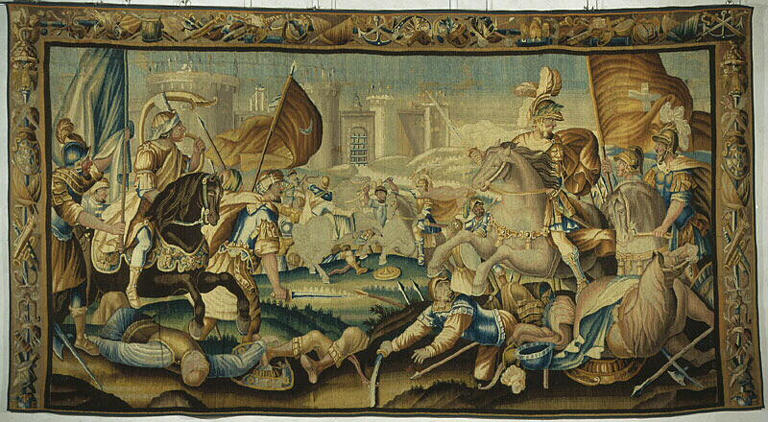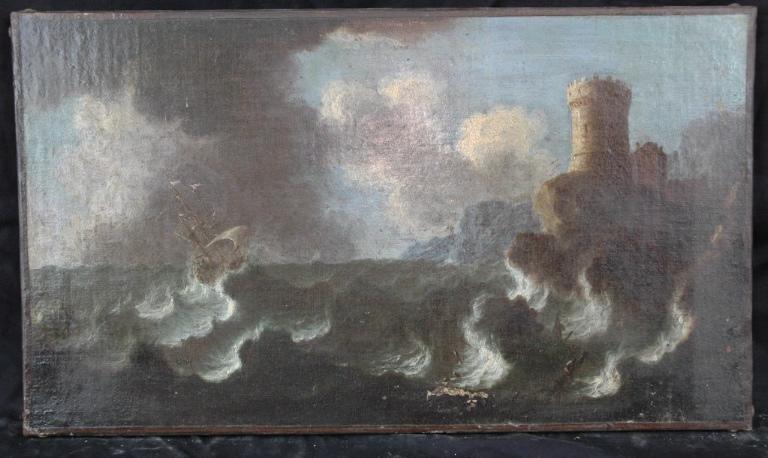Environ 30 résultats pour « Citadelle »
-

Citadelle
Une citadelle est une partie de ville fortifiée, une forteresse pouvant faire office de prison d'état. Les fortifications peuvent éventuellement se limiter à un château fort, un palais.
-

SIEGE DE LA CITADELLE D'ANVERS. (titre inscrit)
-
- Domaine(s) :
- Estampe
- Ethnologie
- Histoire
-
- Sujet représenté :
- Anvers
- Artillerie
- Citadelle
- Infanterie
- Opération militaire
-
- Datation :
- XIXe siècle
-
-

VUE DE LA VILLE ET DE LA CITADELLE D'ANVERS (titre inscrit)
-
- Domaine(s) :
- Estampe
- Ethnologie
-
- Datation :
- XIXe siècle
-
-

-
- Artiste(s) :
- Jean-Germain Drouais
UNE CITADELLE
-
- Domaine(s) :
- Dessin
-
- Sujet représenté :
- Citadelle
- Quartier (ville)
-
- Datation :
- XVIIIe siècle
-
-

Vue d'une citadelle
-
- Domaine(s) :
- Dessin
-
- Sujet représenté :
- Citadelle
- Colline
- Maison
- Paysage
- Quartier (ville)
- Végétation
-
- Datation :
- XIXe siècle
-
-

-
- Artiste(s) :
- Yvonne Jean-Haffen
Moncontour : une citadelle et son clocher [titre attribué]
-
- Domaine(s) :
- Dessin
-
- Sujet représenté :
- Citadelle
- Clocher
- Moncontour (Côtes-d'Armor)
- Paysage
- Ville
-
- Datation :
- XXe siècle
-
-

-
- Artiste(s) :
- Yvonne Jean-Haffen
Autocar devant la citadelle : Brest [titre attribué]
-
- Domaine(s) :
- Dessin
-
- Sujet représenté :
- Brest
- Citadelle
- Femme
- Marine de guerre
- Militaire
- Place (voie)
-
- Datation :
- XXe siècle
-
-

-
- Artiste(s) :
- Yvonne Jean-Haffen
Citadelle de Calvi [titre attribué]
-
-

-
- Artiste(s) :
- Léon Belly
LA CITADELLE DE MOKATAN, PRES DU CAIRE
-
-

-
- Artiste(s) :
- Jean-Baptiste Corot
VOLTERRA, LA CITADELLE
-
-

-
- Artiste(s) :
- Horace Vernet
ATTAQUE DE LA CITADELLE D'ANVERS.22 DECEMBRE 1832
-
- Sujet représenté :
- Anvers
- Blessure
- Canon (artillerie)
- Château
- Citadelle
- Duc de Bassano
- …
-
- Datation :
- XIXe siècle
-
-

PRISE DE LA CITADELLE DE SAIGON.17 FEVRIER 1859
-
- Sujet représenté :
- Arbre
- Arecaceae
- Citadelle
- Drapeau
- Hô-Chi-Minh-Ville
- Marine de guerre
-
- Datation :
- XIXe siècle
-

-
- Artiste(s) :
- Adam François van der Meulen
REDDITION DE LA CITADELLE DE CAMBRAI.18 AVRIL 1677
-
- Sujet représenté :
- Cambrai
- Carrosse
- Cavalerie
- Citadelle
- Louis XIV de France
-
- Datation :
- XVIIe siècle
-
-

-
- Artiste(s) :
- Joseph-Félix Bouchor
Citadelle de Verdun : casemate des artilleurs, Verdun, Juil…
-
- Domaine(s) :
- Peinture
-
- Datation :
- XXe siècle
-
-

Porte de la Citadelle à Téhéran
-
- Domaine(s) :
- Asie de l'Est
- Photographie
-
- Sujet représenté :
- Citadelle
- Porte de ville
- Téhéran
-
- Datation :
- XIXe siècle
-
-

-
- Artiste(s) :
- Maxime Lalanne
La citadelle de Blaye
-
-

-
- Artiste(s) :
- Anonyme
CITADELLE, ENTREE DU VIEUX PORT
-
- Domaine(s) :
- Ethnologie
- Photographie
-
- Datation :
- XXe siècle
-
-

-
- Artiste(s) :
- Anonyme
Antoinette
-
- Domaine(s) :
- Marine
- Pays basque
- Photographie
-
- Sujet représenté :
- Bateau à vapeur
- Bayonne
- Citadelle
- Entrepôt
- Portrait
- Trois-mâts
-
- Datation :
- XXe siècle
-
-

-
- Artiste(s) :
- Bernardo Castello
Scène de combat de cavalerie
-
- Domaine(s) :
- Tapisserie
-
- Sujet représenté :
- Ancre (mouillage)
- Armure (équipement)
- Balance (instrument)
- Bouclier (arme)
- Canon (artillerie)
- Carquois
- …
-
- Datation :
- XVIIe siècle
-
-

-
- Artiste(s) :
- Charles Le Brun
PRISE DE LA VILLE ET DE LA CITADELLE DE GAND EN SIX JOURS.1…
-
- Domaine(s) :
- Peinture
-
- Datation :
- XVIIe siècle
-
-

-
- Domaine(s) :
- Estampe
- Métrologie
-
- Désignation :
- calendrier
-
- Datation :
- XXe siècle
-
-

La France combat pour la paix
-
- Domaine(s) :
- Numismatique
-
- Sujet représenté :
- Citadelle
- Coq
- Foudre
- Laurus nobilis
- Louis-Philippe Ier
- Militaire
-
- Datation :
- XIXe siècle
-
-

-
- Artiste(s) :
- Charles-Jean Hallo
Château Royal, Senlis
-
- Domaine(s) :
- Photographie
-
- Sujet représenté :
- Château
- Citadelle
- Senlis (Oise)
-
-

-
- Artiste(s) :
- Aimé et Louis Duthoit
Amiens : restitution dans son état du XVIe siècle de la por…
-
- Domaine(s) :
- Dessin
-
- Sujet représenté :
- Amiens
- Charrette
- Citadelle
- Fortification
- Porte de ville
-
- Datation :
- XIXe siècle
-
-

-
- Artiste(s) :
- Aimé et Louis Duthoit
Amiens : la porte de Secours à la citadelle, (vers 1840) ; …
-
- Domaine(s) :
- Dessin
-
- Sujet représenté :
- Amiens
- Citadelle
- Fortification
- Porte de ville
-
- Datation :
- XIXe siècle
-
-

-
- Artiste(s) :
- Anonyme
Dieppe - Ville de la Haute-Normandie située à 49d.57' de La…
-
- Domaine(s) :
- Carte géographique
- Dessin
-
- Datation :
- XVIIIe siècle
-





